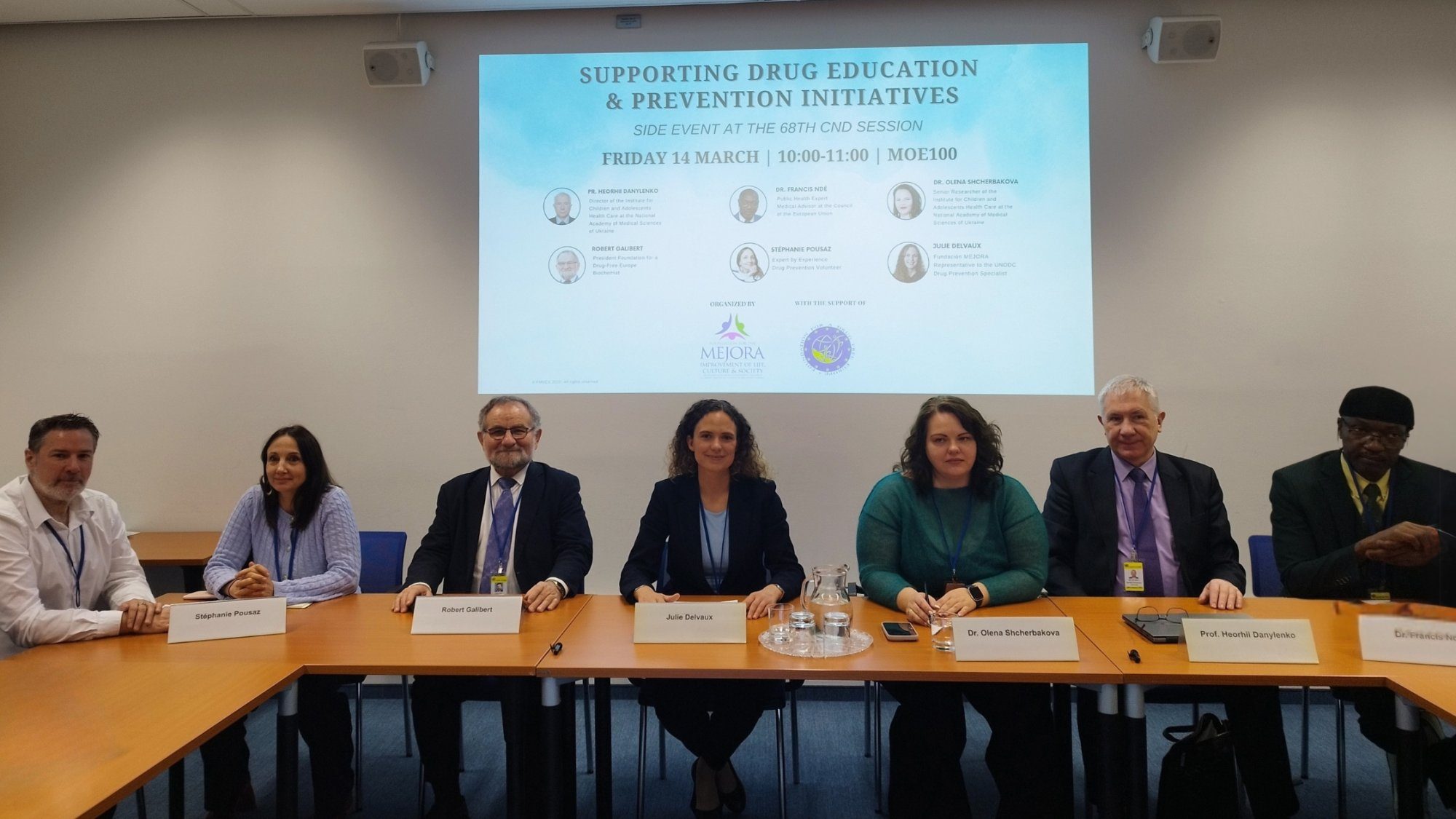Health & Society
Experts Warn Against the Dangers of Cannabis & Synthetic Drugs at UNODC CND68 in Vienna

At the 68th session of the Commission on Narcotic Drugs (CND68) in Vienna, a crucial side event titled Supporting Drug Education and Prevention Initiatives brought together experts, policymakers, and former users to discuss the dangers of drug use and the importance of prevention. The event was organized by Fundacion para la Mejora de la Vida la Cultura y la Sociedad (Foundation for the Improvement of Life Culture and Society), an international foundation covering many societal issues with an educational and learning approach, and an important program on drug prevention; it was co-organized with the support of the specialized network of the Foundation for a Drug Free Europe, which counts with over 100 grassroots groups in Europe that do one on one prevention with The Truth About Drugs campaign.
This side event underscored the urgent need for coordinated global action to curb the rising tide of drug abuse, which continues to devastate communities worldwide.
Julie Delvaux, UNODC representative for the ECOSOC recognized Fundacion Mejora, set the tone for the session, emphasizing the need for early intervention: “The earlier we act, the more lives we can save, and the more we can reduce the harm being created by drugs.” She stressed that drug use is not merely a health issue but a social crisis affecting multiple sectors, including crime rates, economic stability, and mental health. With millions of people affected globally, the challenge is immense, and prevention emerges as the most effective long-term solution.
The event featured a range of speakers, from scientists to former drug users, all advocating for strong educational tactics in the field of education to increase the awareness of the dangers of drugs and comprehensive prevention efforts. Their insights painted a stark picture of the drug problem, reinforcing that public health policies should focus on preventing first use, rather than managing addiction after it has already taken hold.
Synthetic Cannabinoids: The Hidden Danger
Robert Galibert, President of the Foundation for a Drug-Free Europe (FDFE) and an expert in biochemistry, gave a scientific breakdown of synthetic cannabinoids, a growing threat in drug markets worldwide. His presentation delved into the biochemical mechanisms through which these substances interact with the human body, explaining how they are far more potent than natural cannabis and pose significant risks to both mental and physical health.
“These substances are far more potent and dangerous than natural cannabis,” Galibert warned. He elaborated on how synthetic cannabinoids, initially developed for medical research, were hijacked by illicit manufacturers seeking to exploit legal loopholes. These unregulated substances have resulted in severe health complications, including heart problems, severe vomiting, hallucinations, and in some cases, fatal overdoses.
He explained how synthetic cannabinoids disrupt the body’s endocannabinoid system, which plays a crucial role in regulating mood, memory, and overall physiological balance. Similarly to phyto-cannabinoids (found in cannabis), these synthetic substitutes bind to cannabinoid receptors, but activate them much more violently, resulting in extreme and unpredictable effects.
He pointed out the fat solubility of cannabis, which allows it to accumulate in the body and cause prolonged impairment. “The elimination of THC takes weeks, meaning a user is under the influence long after consumption,” he said. Comparing it to alcohol, he added, “Alcohol is eliminated in 24 hours, but THC (like phyto- or synthetic-cannabinoids) remains in adipose tissue for weeks, making its effects long-lasting and underestimated.” This insight is particularly crucial in the debate surrounding cannabis legalization, as it challenges the misconception that marijuana use is harmless or easily manageable.
A Former Addict’s Testimony: Real Impact of Drug Use
Perhaps the most moving moment of the event came from Stephanie, a former drug user from Switzerland. Speaking in French, she detailed her descent into addiction, which started with cannabis and quickly escalated to LSD, cocaine, heroin, and methadone. Her candid account exposed the progressive nature of drug addiction, challenging the notion that cannabis use can remain recreational without leading to further substance abuse.
She described how peer pressure led her to experiment: “At first, I didn’t want to be part of the group. But as time passed, I felt isolated. So, I gave in.” Like many young people, she was drawn in by the social aspects of drug use, not realizing the long-term consequences. Her story is a stark reminder that drug addiction often starts with social normalization—what seems like a harmless decision can spiral into a devastating dependency.
Her turning point came when she found herself “in a place without money, without a home, and with a lot of pain”, destitute, and suffering from severe withdrawal symptoms. “I hit rock bottom. That’s when I knew I had to change,” she revealed. After enough attempts at rehabilitation, she finally succeeded in overcoming addiction and now, after recovering control over her life and building a company that gives work to some 30 people, she has made it her mission to help others avoid the same fate.
Her story was a powerful testament to the necessity of prevention and education. She emphasized that had she been properly educated about the dangers of drugs in her early teens, she might have avoided the path she took. She urged policymakers to implement early education programs in schools, providing children with the knowledge and resilience to resist peer pressure.
The Science and Policy Debate on Cannabis
Dr. Francis Nde, medical advisor to the Council of the European Union, focused on the health consequences of cannabis use. He cited studies linking cannabis consumption to testicular cancer, cardiovascular disease, and mental disorders like schizophrenia. “The effects of cannabis are not just short-term; they are passed down through generations,” he emphasized, referring to recent studies on epigenetic effects. He called on governments to take these scientific findings into account when considering cannabis legalization, arguing that public health should take precedence over economic incentives or political pressures.
A tense discussion emerged when a psychologist from Poland, questioned whether alcohol should be considered the primary gateway drug instead of cannabis. Galibert responded with scientific data, reinforcing that while alcohol is a risk factor, cannabis is a stronger predictor of progression to harder drugs due to its persistent impact on the brain. He detailed how THC alters brain chemistry, making individuals more susceptible to seeking stronger substances to achieve similar effects.
Another controversial topic was Ukraine’s potential legalization of medical cannabis. Dr. Olena Shcherbakova, a senior researcher from Ukraine’s National Academy of Medical Sciences, presented the findings of her research with Dr Heorhii Danylenko and warned against legalization efforts: “We understand the risks and are actively working to prevent legalization. But we face strong lobbying efforts.” Her remarks underscored the geopolitical and policy challenges surrounding cannabis regulation. The debate highlighted the global divide in drug policy, where some nations push for legalization while others fight to uphold strict regulations to protect public health.
The Road Ahead for Prevention and Policy
As the session wrapped up, Delvaux reiterated the key message: Prevention through education, early intervention, and international cooperation is crucial in the fight against drug abuse. She called for greater investment in public awareness campaigns, school-based prevention programs, and cross-border collaboration to tackle the evolving drug crisis.
Stephanie’s story, Galibert’s scientific analysis, Dr. Nde’s medical expertise, Dr Shcherbakova and Dr Danylenko, all pointed to the urgent need for stricter policies and widespread awareness campaigns. The speakers warned that legalization efforts, particularly for cannabis, pose a significant risk to public health and should be countered with robust prevention strategies.The event at CND68 made it clear: The fight against drug abuse is far from over. But with education, strong policies, and international collaboration, progress can be made in protecting the most vulnerable—especially the youth—from the devastating consequences of drug addiction.
Health & Society
Socioeconomic inequalities drive significant gaps in access to mental health care across the European Union

A study presented at the European Psychiatric Association Congress 2025 reveals deep socioeconomic inequalities in reported need for mental health care across the European Union. The research highlights how financial barriers disproportionately affect lower-income individuals, with significant disparities also linked to education level, whether the person lives in a city or in the countryside, and geographic location.
Led by Dr. João Vasco Santos, a public health physician, health economist, and professor at the University of Porto, the cross-sectional analysis used data from the 2019 European Health Interview Survey (EHIS), covering 26 EU member states. The survey among others asked participants whether they had gone without needed mental health care in the previous 12 months due to financial constraints.
Measuring Unmet Needs: A Financial Lens
The EHIS captures self-reported experiences, focusing specifically on financial reasons as a barrier including to accessing mental health services.
Across the EU, the proportion of self-reported unmet needs for mental health care varied widely — from as low as 1.1% in Romania to as high as 27.8% in Portugal, with a median of 3.6%.
Dr. Santos emphasized that while many European countries have moved toward mixed health systems — blending elements of Beveridge- and Bismarck-style models — financial protection remains inconsistent. Even in countries with universal coverage, out-of-pocket costs for medications, therapy, diagnostic testing, or medical devices can create substantial barriers.
“This is not just about whether care is public or private,” explained Dr. Santos. “Even in systems that are largely public, co-payments can be a burden. And sometimes, vulnerable groups—like migrants or asylum seekers—are excluded altogether.”
Cultural Perceptions Shape Reporting
One of the most striking findings was the stark contrast between Romania and Portugal. Dr. Santos cautioned against interpreting these figures at face value.
“It’s not just about the availability of services — it’s also about awareness and cultural perception,” he said. He noted that in Portugal, “we’re increasingly open about mental health and the mental health service.”
Portugal has been one of the countries that is spearheading the new perception of mental health care. “The UN Convention on the Rights of Persons with Disabilities laid the foundation for the much-needed paradigm shift in mental health. From an exclusively medical approach to one based on the respect of the human rights of persons with mental health conditions and psychosocial disabilities,” Ms Marta Temido, Minister of Health of Portugal told during a United Nations consultation meeting in 2021.
Ms Marta Temido stressed that “In Portugal, we have been making significant efforts to align our laws, policies and practice with human rights.”
She specifically pointed out that “We have clearly made an option for community-based mental health services instead of institutionalization. We have been improving access to outreach care, through the launching of community teams for adults and for children and adolescents.”
In countries like Romania, stigma remains high, and is influenced by a long history of institutionalized care that fails to meet basic human standards. It should be obvious that if the psychiatric system hasn’t evolved much beyond large psychiatric institutions with reported human rights violations, one might think twice before reporting need of help.
Dr. Santos noted that in countries where mental illness is stigmatized or misunderstood, individuals may avoid reporting symptoms altogether. In some cases, people may not perceive a need for care because of limited exposure to mental health education or fear of discrimination.
Education and Inequality
The study also revealed a strong correlation between educational attainment and unmet needs. In 15 out of 26 countries analyzed, individuals with only primary education were significantly more likely to report going without mental health care than those with tertiary education.
“In Bulgaria, Greece, Romania, and Slovakia, this disparity is especially pronounced,” Dr. Santos noted. The pictures across the European countries however is quite complex, as exemplified with France where the opposite is the case. In France people with tertiary education showed a higher unmet need of mental health care. This indicate that further studies may be needed which could look at adjusting for income and other factors. The study conducted only considered the educational related inequalities.
Pandemic Impact and Future Trends
Although the study drew on pre-pandemic data (from 2019), Dr. Santos warned that the pandemic likely exacerbated existing inequalities.
“We know that mental health deteriorated during the pandemic — there was increased violence, isolation, and trauma,” he said. “At the same time, access to care was disrupted. I suspect the next wave of data will show a rise in unmet needs, particularly among lower-income and marginalized groups.”
However, he stressed that longitudinal comparisons must be made carefully, noting that changes in survey design over time can affect results.

“The goal must be to leave no one behind,” Dr. João Vasco Santos
Policy Recommendations addressing socioeconomic inequalities
To address these systemic challenges, Dr. Santos outlined a series of priorities that require coordinated action at both national and regional levels.
First, he emphasized the importance of expanding universal coverage to ensure that all individuals — including migrants and asylum seekers — have access to essential mental health services without facing financial hardship. He called for reforms that would exempt low-income and chronically ill populations from co-payments, even in systems where care is otherwise publicly funded.
Second, he advocated for a shift toward community-based care models, which improve accessibility, reduce stigma, and foster integrated, person-centered treatment approaches.
Third, Dr. Santos underscored the need for national and regional mental health strategies that incorporate public education campaigns aimed at improving health literacy.
“The goal must be to leave no one behind,” he concluded. “Health is an investment — not just in individuals, but in the resilience and equity of society as a whole.”
Health & Society
More than 30 years of difference in life expectancy highlights health inequalities

The study of the World Health Organization (WHO) reveals that they can be responsible for a Spectacular reduction in life expectancy in rich and poor countries.
For example, People living in the country with the highest life expectancy will live on average 33 years more than those born in the country with the lowest life expectancy.
An unequal world
“Our world is uneven. Where we were born, grow, live, work and age considerably influence our health and well-being, “said Director General Tedros Adhanom Ghebreyesus.
Health inequalities are closely linked to the degrees of social disadvantage and the levels of discrimination.
“” Health follows a social gradient by which the area in which people live more disadvantaged, the more their income is lowWho said.
Inequalities are particularly exacerbated in populations faced with discrimination and marginalization, such as indigenous peoples, who have lower expectations of life than their non -Aboriginal counterparts.
This is the case in high -income and low -income countries.
Key targets at risk
The study is the first to be published since 2008, when the WHO Social Health Determinants of Health Declines published its final reporting objectives for 2040 to reduce gaps between and within countries in life expectancy, childhood and maternal mortality.
It shows that these objectives are likely to be missed, and despite a rarity of data, there is sufficient evidence to show that health inequalities have often expanded.
For example, children born in poor countries are 13 times more likely to die before their fifth anniversary than in richer countries.
In addition, modeling shows that the life of nearly two million children per year could be saved by filling the gap and improving equity between the poorest and richest populations of the population in low and average income countries.
In addition, although maternal mortality has decreased by 40% between the 2000s and 2023, the majority of deaths, 94%, still occur in low and lower income countries.
Appeal to action
Who calls for collective action to deal with economic inequalities and invest in social infrastructure and universal public services.
The agency also recommends other stages, in particular on the survival of structural discrimination and the determinants and impacts of conflicts, emergencies and forced migration.
Originally published at Almouwatin.com
Health & Society
A Growing Crisis: The Rise of Ketamine Use Among Britain’s Youth

In the neon-lit corners of London’s underground rave scene, a quiet crisis is unfolding. While cocaine and ecstasy remain staples of Britain’s nightlife, a more insidious trend is gaining traction: ketamine, once relegated to the fringes of the drug world, is surging in popularity among young people. Public health officials, clinicians, and law enforcement agencies warn that its use is escalating into an epidemic with severe consequences for physical and mental health, straining already overburdened treatment systems.
The Data: A Stark Rise in Use
Official figures from the Crime Survey for England and Wales (CSEW), published in January 2024 by the Office for National Statistics (ONS), reveal a troubling trajectory. Ketamine use among 16- to 24-year-olds has nearly doubled since 2019, with 2.1% of respondents reporting use in the past year—a figure experts believe underestimates the true scale. Urban areas tell an even grimmer story. A 2023 study in The Lancet Regional Health—Europe found that in London, ketamine accounted for 12% of all new drug treatment admissions in 2022, up from 4% in 2018. The European Monitoring Centre for Drugs and Drug Addiction (EMCDDA) now ranks the UK as having the highest prevalence of ketamine use in Western Europe, surpassing France and Germany.
Why Ketamine? Accessibility and Misconceptions
Ketamine’s dual identity—as both a legally prescribed medication and an illicit substance—fuels its accessibility. Originally developed as a veterinary anesthetic, it remains a medically approved painkiller and antidepressant. However, illicit versions, often diverted from veterinary supplies or produced in clandestine labs, have flooded black markets. The National Crime Agency (NCA) seized a record 3.4 tons of ketamine in 2023, a 40% increase from 2021, with much of the supply traced to illegal manufacturing in China and India.
Affordability amplifies its appeal. A gram of ketamine costs as little as £10 ($13) in clubs or online, compared to £30 ($39) for a gram of cocaine. For young people navigating soaring living costs, this price gap is a critical factor. Meanwhile, misconceptions about safety persist. Unlike opioids, ketamine does not suppress breathing, leading many users to underestimate its risks. Yet studies confirm that its long-term effects—though less immediately lethal—can be equally devastating.
Health Consequences: Bladders, Brains, and Mental Health
Chronic ketamine use exacts a severe physical toll. The drug is linked to “ketamine bladder syndrome,” a condition causing painful ulcers, incontinence, and kidney failure. A 2022 review in Nature Reviews Urology found that 20–30% of regular users develop urinary symptoms, with some requiring surgical intervention. Hospitals report a surge in cases: urologists at University College London Hospital note a sharp rise in young patients needing catheters or bladder reconstructions, often in their early 20s.
Mental health risks are equally alarming. Ketamine’s dissociative effects—inducing out-of-body experiences—can trigger psychosis, paranoia, and depression. A 2023 longitudinal study in Psychological Medicine tracked 500 young users over five years and found that 40% developed persistent psychiatric symptoms, with 15% requiring hospitalization. Neurological research underscores that while ketamine does not cause addiction in the traditional sense, it alters the brain’s reward system, creating psychological dependence.
Social Drivers: Isolation, Economic Anxiety, and the Digital Age
The surge in ketamine use intersects with broader societal shifts. Post-pandemic mental health data reveals a crisis among young people, with rising rates of loneliness and anxiety. A 2024 Institute for Public Policy Research (IPPR) report found that 60% of young ketamine users cited loneliness or anxiety as key motivators for use. Economic pressures compound these issues: stagnant wages, housing insecurity, and the gig economy’s instability create fertile ground for escapism.
The digital age further fuels the trend. Online communities on platforms like Reddit and TikTok glamorize ketamine’s hallucinogenic effects, while encrypted apps facilitate discreet purchases. The National Crime Agency notes that encrypted messaging services now dominate ketamine distribution, enabling buyers to bypass traditional street-level dealers.
Policy Paralysis: A Legal Gray Area
Despite the crisis, ketamine remains a Class C drug in the UK, carrying a maximum penalty of two years in prison for possession. Critics argue this classification downplays its harms. Academic analyses, including studies from the University of Kent, highlight that Class C sends a misleading signal about risk. Reclassification to Class B—a move that would increase penalties and unlock additional treatment funding—has been debated but not enacted.
Government efforts to address the issue remain fragmented. A £2 million ($2.6 million) allocation in 2023 aimed to expand ketamine-specific treatment programs, but advocacy groups describe this as insufficient. Waiting times for specialized care often stretch to six months, and many clinics lack staff trained in ketamine-related disorders.
The Road Ahead: A Call for Urgency
The ketamine crisis demands a multifaceted response. Stricter regulation of online sales, expanded mental health services, and public awareness campaigns targeting schools and parents are critical. Research from the University of Exeter stresses the need to destigmatize conversations about ketamine’s risks, particularly among educators and families.
For now, the human cost continues to mount. In Bristol, a 22-year-old student, who requested anonymity, described her three-year ketamine addiction as “a slow-motion car crash.” After losing her university place and developing severe bladder pain, she entered rehab in 2023. “I thought I was invincible,” she said. “But ketamine took everything.”
As Britain grapples with this hidden epidemic, the stakes grow higher with each passing month. Without decisive action, the next generation may pay the price.
-

 EU & the World5 days ago
EU & the World5 days agoWhere Is Lester Holt Going After ‘NBC Nightly News’? His Next Job
-

 Sports6 days ago
Sports6 days agoEuropa League 2024-2025: Bodo/Glimt-Tottenham, the likely lineups
-

 EU & the World4 days ago
EU & the World4 days agoWhy Was ‘Night Court’ Canceled? Find Out the Reason
-
Travel6 days ago
Vietnam is introducing a 10-year golden visa. Here’s what we know so far
-

 Sports7 days ago
Sports7 days agoJuventus, new home jersey 2025/26 unveiled
-

 Sports5 days ago
Sports5 days agoDucati, Pecco Bagnaia dejected: “I can’t find the feeling”
-

 Sports2 days ago
Sports2 days agoMatteo Berrettini forced to retire amid tears at Internazionali d'Italia
-

 Sports7 days ago
Sports7 days agoFiorentina, renewal for Palladino: until 2027 on the purple bench





















